Key Points:
- Sweating is an adaptation that helps some animals cope with the heat, but it is relatively rare.
- Horses have the most efficient sweating and cooling system, with humans coming in second.
- While donkeys and zebras can sweat, they only sweat heavily when under high stress or pain.
Sweat might be messy, smelly, and generally unappealing, but it is an important human phenomenon that helps to make us what we are. Perspiration is a cooling mechanism that kicks in to keep the internal body temperature at a reasonable 98.6 degrees Fahrenheit. Primarily composed of water, potassium, salt, and other minerals, sweat literally serves to release excess heat generated by the muscles when other methods of cooling have failed. Otherwise, if we did not sweat, we would overheat and die. But did you know that there are animals that sweat, too?
Despite how necessary it is for human health, perspiration is a rare phenomenon in the animal kingdom. True sweating is mostly limited to primates and equines. Instead, most animals have evolved to regulate their body temperature in all kinds of different ways, including panting, rolling around in the mud, swimming in the water, lounging in shade, and urinating or defecating all over their body. Some animals also have exceptionally long ears with a lot of blood vessels that release excess heat into the air.
The anatomy of sweating is critical to understanding how it works. To simplify things a little, there are generally two different types of sweat glands: the apocrine glands and the eccrine glands. Apocrine glands, located near the base of the hair follicles, have primarily evolved for the purpose of producing odors as pheromones, territorial markers, and warning signals; they’re very rarely used to cool the body on warm days (though there are some exceptions). Eccrine glands, located close to the surface of the skin, mostly produce sweat for the purpose of thermoregulation.
The majority of mammals are covered in apocrine glands over most of their body. Primates (chimps and gorillas in particular) are the only group of mammals with a relatively high number of eccrine glands in comparison to apocrine glands.
Humans are likewise the only species on the planet whose bodies are almost completely covered in eccrine glands (except for a few places like the armpits, ear canals, eyelids, and nipples). We contain between two million and five million of these glands all over our bodies. Together they produce around 12 liters of sweat a day.
The evolution of (relatively) bare skin was believed to be a necessary precondition for the evolution of sweat in humans. Sweat easily evaporates from bare skin, whereas it would accumulate and gather around dense hair follicles, which would have a counterproductive effect. The evolution of sweat, in turn, allowed humans to hunt game over long distances on hot days, while most other species would easily overheat.
With all that background detail in place, this article will consider the top 7 animals (besides humans) that produce some form of perspiration. The list will only include the animals that sweat to release heat, cool the body, or moisturize the skin in some way. It will not include general perspiration for other survival purposes.
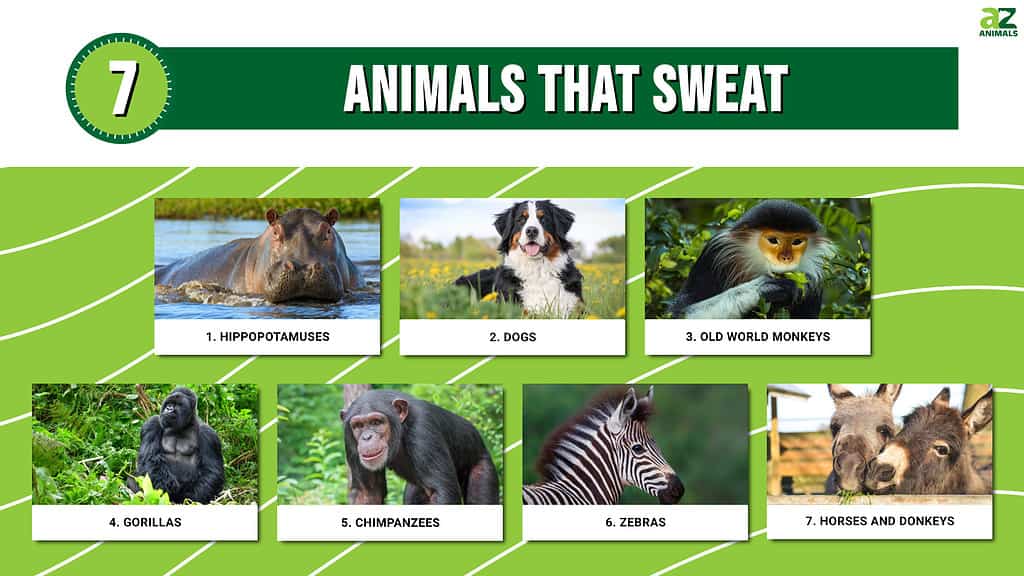
What Animals Sweat?
You may be wondering, what animals sweat? Not many, actually. It seems that most non-human animals have their own unique ways of dealing with heat. Pigs, for instance, rely on a process called evaporative cooling through their snouts to stay cool. Dogs use panting as another form of evaporative cooling – they open their mouths wide and exhale to release warm air from their lungs while inhaling cooler outside air. Elephants also use this same method of panting to cool themselves down.
Desert-dwelling animals such as camels, lizards, and ostriches have evolved different methods for keeping cool due to the lack of shade available in the desert environment. These creatures can often be seen standing on one leg or lying on sand dunes with outstretched wings that act like radiators – dissipating heat from their body surface. But what animals sweat? We will get into detail about what animals sweat in greater depth below.
#7 Horses and Donkeys
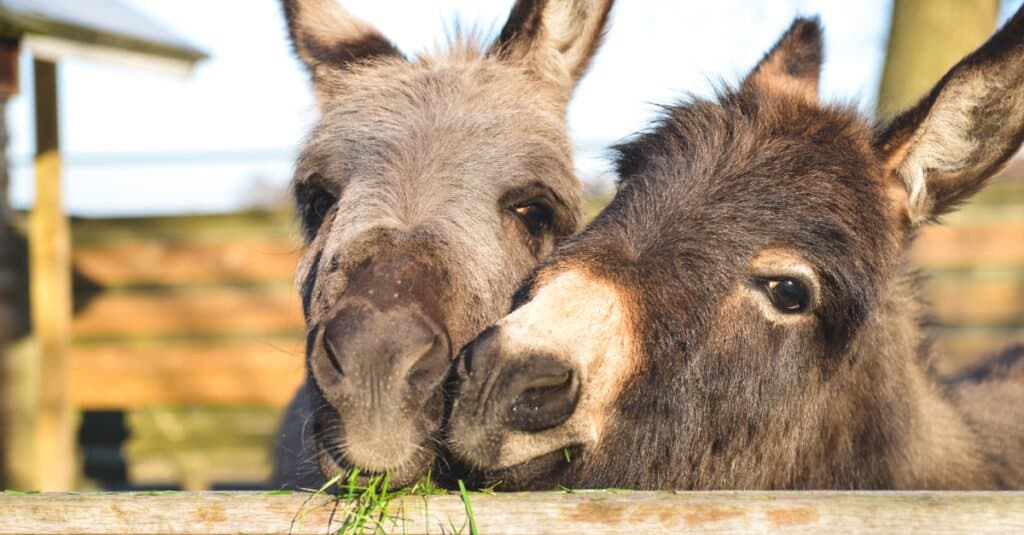
Donkeys have been known to sweat due to heat exposure and intravenous adrenalin infusion.
©babeaudufraing/Shutterstock.com
Anyone who has ever worked with horses for long enough will notice that they sweat heavily when they are working hard. They also have the ability to produce a type of foam or lather over their bodies, particularly around the hind legs and neck, when exercising or working in hot environments. This foam contains a unique protein called latherin that gives the sweat a foamy appearance when it is in an area where friction occurs, such as between the thighs.
The latherin allows the perspiration to work through the entire surface of the waterproof hair, from the base to the tip. This, in turn, increases its exposure to air, so it will eventually evaporate from the body. Latherin is also present in saliva, where it helps the horse chew high-fiber foods.
When it’s working particularly hard, a horse can easily lose around four gallons of sweat per hour, depending on the intensity of the exercise and the temperature of the surrounding environment. By comparison, a horse typically drinks between 10 and 20 gallons of water per day. The effectiveness of this cooling system reduces the need for the horse to pant very much in hot conditions, and it may be a sign of a health problem if the horse cannot properly sweat.
Horses have an extensive network of blood vessels just under the skin that help them regulate their body temperature. When they sweat in hot weather, these blood vessels expand to maximize the amount of heat dissipated. In cold weather, the blood vessel contract and divert blood flow deeper into the body. This is one of the specialized mechanisms that allow the horse to be such an amazing athlete.
While donkeys are also able to sweat, they do so much less than a horse. The donkey’s primary method of dispersing extra heat is through its large ears, which have multiple blood vessels close to the surface of the skin so that heat can escape. Donkeys do not have the same blood vessels that horses do under their skin, so they are not able to adapt to changes in temperature as quickly as horses can. Donkeys generally only sweat when they are under severe stress, so it should be seen as a sign that the donkey is in distress and may need help.
#6 Zebras
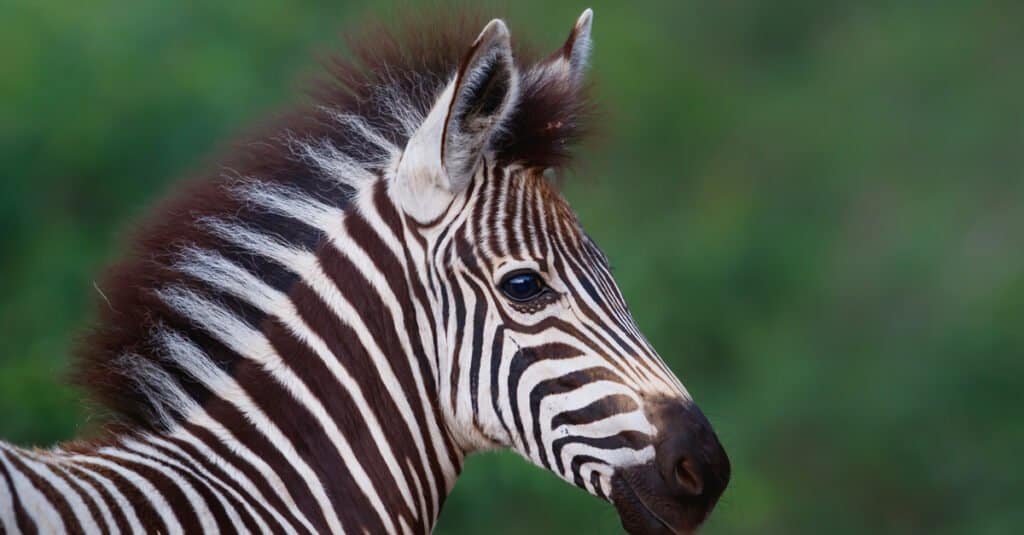
A recent scientific study shows the possibility that zebra stripes may be used to control body temperature.
©Henk Bogaard/Shutterstock.com
Zebras, just like horses and donkeys, are a member of the genus Equus. It’s, therefore, no surprise that their bodies also have the ability to create the same foamy latherin that helps to facilitate evaporation and cooling around the hair. What’s particularly fascinating about the zebra is that the latherin might interact with the stripes in unique ways. Some scientists have speculated that erect black hairs could promote sweat evaporation during the hottest parts of the day.
The evolution of zebra stripes still remains a contentious subject, however, and thermoregulation is just one hypothesis among many others. In general, zebras are much more similar to donkeys than to horses.
#5 Chimpanzees
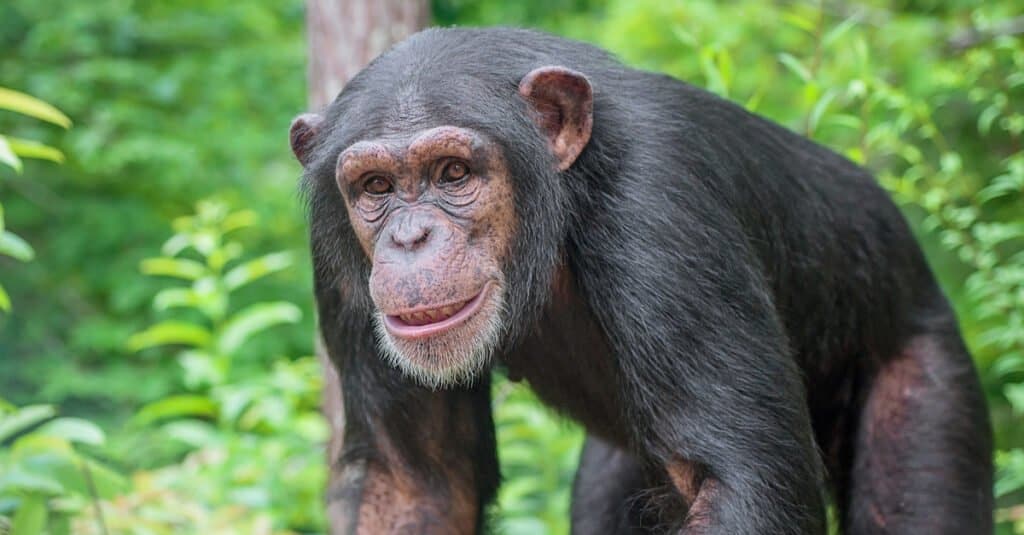
Like humans, chimpanzees sweat. However, they also use additional cooling methods to compensate.
©Crystal Alba/Shutterstock.com
The chimpanzee is often said to be humanity’s closest living relative because we share some 98.8% of the same DNA. One of the traits we share in common with them is the ability to sweat.
As mentioned previously, chimpanzees have a high ratio of eccrine to apocrine glands, presumably to help them regulate the temperature of their bodies. Nevertheless, their sweating isn’t quite as efficient as a person’s, both because of a lower density of glands on their skin and because of their thick fur. For this reason, the chimpanzee still relies on other methods to stay cool.
#4 Gorillas
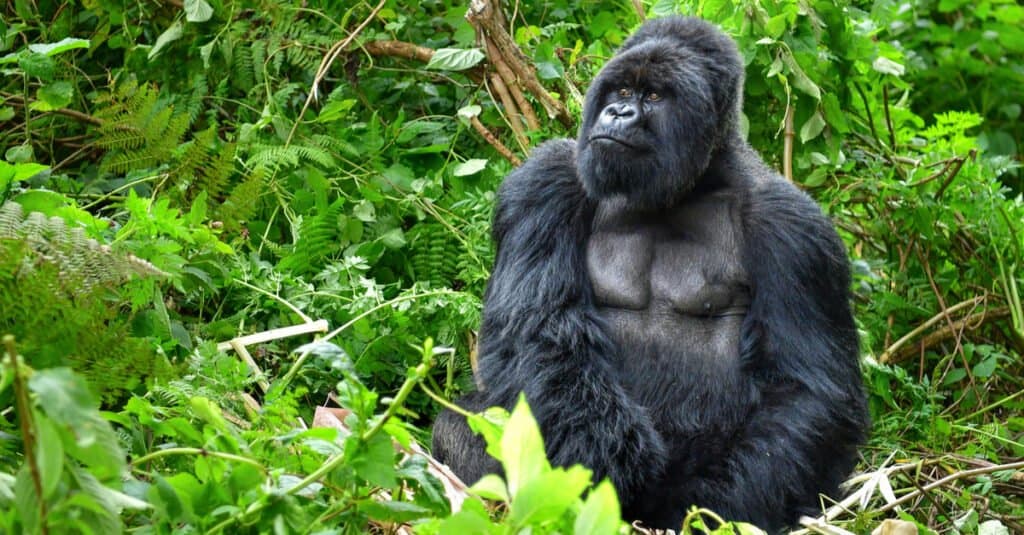
Gorillas not only use sweat to cool down but also as a means of communication.
©Onyx9/Shutterstock.com
Another close human relative, gorillas, also have the ability to sweat in warm weather to remain cool and comfortable, but thermoregulation is only one purpose of the sweat glands.
Just like chimpanzees and humans, gorillas have a specialized tissue called the axilla or axillary organ located on the armpits. This organ is particularly pronounced in male gorillas. It is composed of four to six layers of glands that secrete sweat and other scents. This actually serves the primary purpose of facilitating communication within the entire group. The scent provides an alarm signal to other group members when potential threats are lurking nearby. It’s also a useful sign of reproductive availability.
For some unknown reason, humans still retain the strong armpit odor, despite seemingly serving little purpose. This has generated a bit of a scientific mystery.
#3 Old World Monkeys
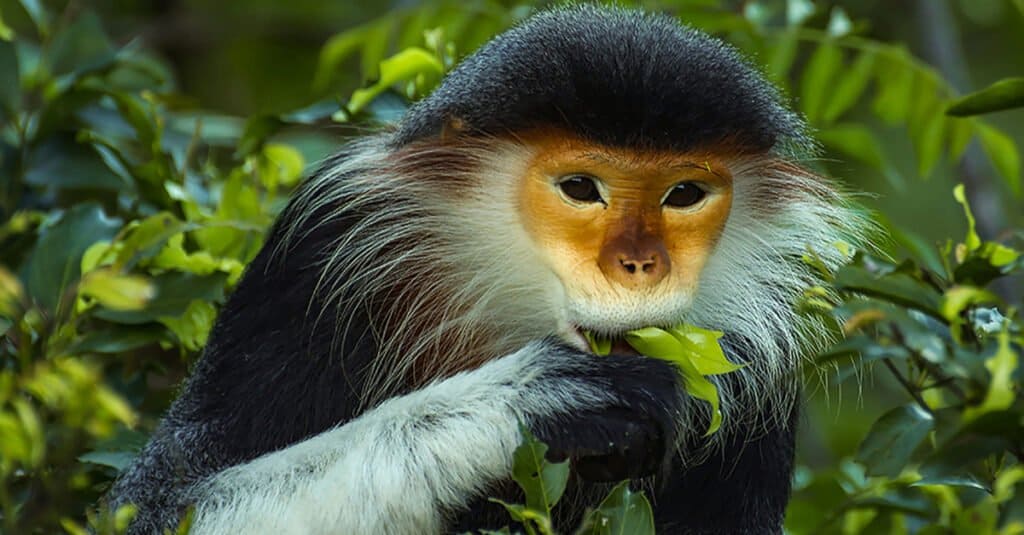
Though not all Old World monkeys sweat, many do, including macaques and baboons.
©Scenic Vietnam/Shutterstock.com
The Old World monkey is an entire family of primates, mostly native to Africa and Asia. Macaques and baboons are the most well-known members of this group. It does not include New World monkeys, like marmosets and tamarins, as well as the lemurs of Madagascar.
The macaque is a genus of Old World monkeys; there are 23 species within this group, most of them native to Asia. The best-known species are probably the Rhesus macaque and the Japanese macaque. While they do have the ability to sweat, it’s not quite as pronounced as their great ape cousins. This is probably due to the fact that they have a fairly even split between eccrine and apocrine glands on their skin.
The baboon is another genus of Old World monkeys, comprising six distinct species native to Africa and the Arabian Peninsula. They are characterized by a dog-like muzzle, powerful jaws, sharp teeth, short tails, a relatively large body size, and protruding buttocks. Baboons also appear to have quite a few eccrine glands covering their bodies. Some studies confirm that they do, in fact, produce sweat in response to heat.
#2 Dogs
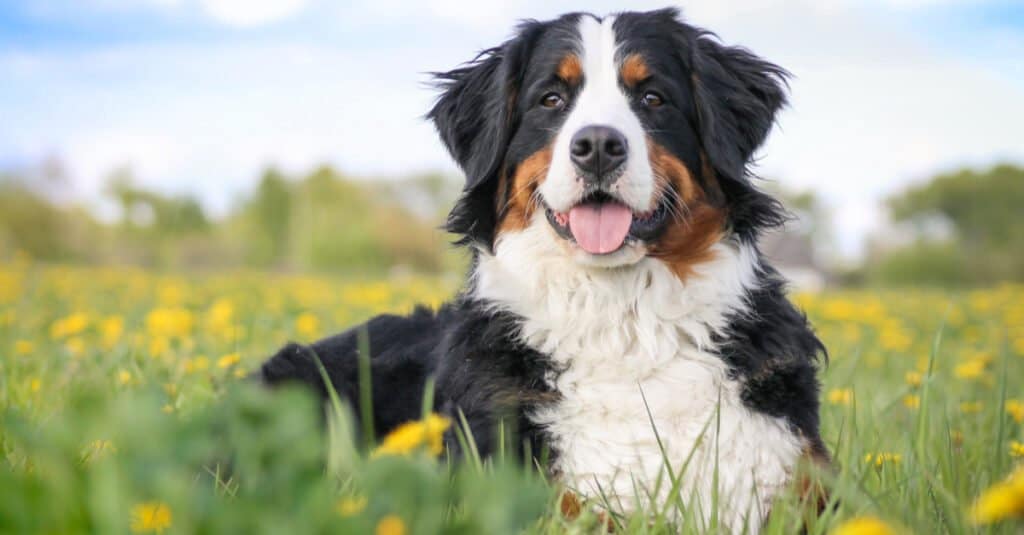
Even man’s best friend sweats — around their paw pads.
©Eve Photography/Shutterstock.com
You may be a little surprised to learn that dogs have a cluster of eccrine glands (sometimes also called merocrine glands) around their paw pads. These have a similar function as human sweat glands to cool the body. If you look closely, you can sometimes see perspiration gathering around the paws during a hot day. The relatively bare skin makes perspiration possible. But this is also why the sweat is restricted to the paw pads only.
Because of their thick fur, dogs cannot sweat over most of their bodies. They must still pant to remain cool. Given that their ability to sweat is so limited and rather inefficient, dogs can overheat relatively quickly. A good way to help them cool down is to place their feet in cool water.
#1 Hippopotamuses

A hippo’s perspiration is unique, as it is more of a sticky mucus secretion rather than typical sweat.
©Radek Borovka/Shutterstock.com
Despite popular misconception, the hippopotamus does not produce true sweat at all, but it’s still fascinating for a different reason. This big semi-aquatic African herbivore secretes a red sticky mucus-filled liquid that functions as a kind of moisturizer, sunscreen, and antibiotic. This perspiration is initially colorless, but it actually turns red and brown when reacting with certain pigments. People have given it the nickname of blood sweat, even though it contains neither blood nor true sweat.
The hippopotamus’s skin is extremely sensitive and prone to drying out. For this reason, they like to stay in the water or roll around in the mud to keep their delicate skin moisturized. However, they are also very territorial creatures, and they will sometimes venture onto land to chase predators or other intruders out of their domain. In those cases, their mucus acts as further protection and lubrication for their skin until they can return to the water.
Animal Sweat vs. Human Sweat
The main difference between animal sweat and human sweat is that animals only produce sweat in small areas, while humans can produce sweat all over their bodies, up to three gallons per day! Human sweat contains more water than animal sweat, making it much more visible when a person perspires.
Humans also have two types of glands in the skin responsible for producing sweat: eccrine and apocrine. Most animals do not have eccrine glands, and the ones that do, have fewer of them, making humans more efficient sweat producers. Another difference between animal sweat and human sweat is that equine animals produce foam or lather, and humans don’t.
7 Animals That Sweat the Most
Donkeys, zebras, and horses sweat when they are under intense physical exercise or in high temperatures. Horses and zebras can lose up to four gallons of sweat per hour, depending on the intensity and temperature. Donkeys, however, have a different method of dispersing heat than horses. The large ears of a donkey act like radiators; they contain multiple blood vessels near the surface of their skin which allows heat to escape efficiently. Sweating is not as common for donkeys as it is for horses, typically only occurring when they are facing extreme stress.
Gorillas, chimpanzees, and old-world monkeys all produce sweat. Primates have evolved to sweat in order to regulate their body temperatures, but the process is not as efficient as what humans experience. This is due to two factors: primates have a low density of eccrine and apocrine glands, which are responsible for sweating, compared with human skin, and because of the thick fur that covers much of their bodies, less sweat can evaporate from their skin. Therefore, primates typically rely on other cooling strategies, such as panting or seeking shade during hot days in order to cool down.
Dogs are also capable of sweating. Unlike humans, dogs don’t sweat all over but instead primarily focus on the feet and pads. Dogs have a cluster of eccrine glands (sometimes also called merocrine glands) located in the paw pads that are responsible for cooling them down when they become too hot. These eccrine glands produce sweat with very little water content; it is mostly made up of salt and other minerals, which evaporate quickly, allowing heat to be released from the dog’s body.
Summary of 7 Animals That Sweat
Sweating is an adaptation that helps dispel excess heat, but it is relatively rare in the animal world. Here are seven animals that share this ability with humans:
| Number | Animal |
|---|---|
| 1 | Hippopotamuses |
| 2 | Dogs |
| 3 | Old World Monkeys |
| 4 | Gorillas |
| 5 | Chimpanzees |
| 6 | Zebras |
| 7 | Horses and Donkeys |
The photo featured at the top of this post is © Shchipkova Elena/Shutterstock.com
Thank you for reading! Have some feedback for us? Contact the AZ Animals editorial team.






